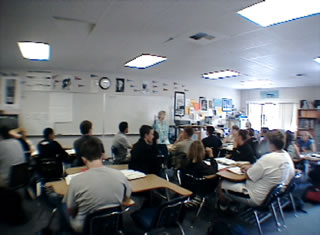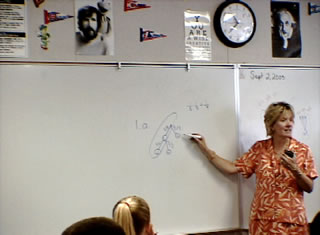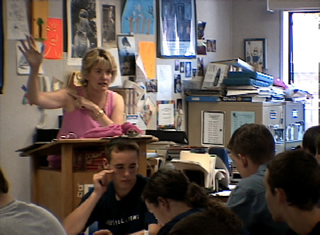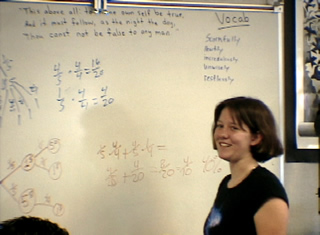Context
Where do I teach?
Content
What are my students learning?
Teaching Practice
What's my approach?
Reflections
Resources
Standards
Archive
|
The First Two weeks: Setting Norms in the Context of Mathematical Work
The following are examples of how I work to establish a climate that is highly participatory, academically rigorous, yet comfortable and consistent for my students. |
Video Footage from the First Weeks of School |
Discussing rules in context
|
1:51 |
|
I don’t believe in starting the year with a bunch of rules. I prefer, instead, to have situations arise, and then we can discuss the relevant rules in context. This way, instead of listing 25 rules or so about hats, bells, bathroom, etc. which they invariably will have trouble remembering, it all makes sense to my students, Also, kids like to know why you’re making the rule that you’re making. For example, this is a junior level class, so I ramp things up. They know that in order to be treated more like an adult, it is my expectation that they act more like an adult. This includes greater academic rigor, conscientious drinking and eating in class, and appropriate dress in the workplace. Speaking of dress, it is very important to me that I do not have to embarrass anyone by calling attention to inappropriate dress. I lay it out ahead of time exactly what I feel is “across the line” so there are no surprises. That goes for language as well. And finally, kids often attempt to hide under hats and the like. I tell my students that it is important for me to see their eyes. It’s about being connected.
|
play
|
Quicktime Player
high • low
get plugin |
Windows Media
high • low
get plugin |
|
Homework system
and other logistics
|
7:05 |
|
Homework is graded for completion and effort. I do not score homework based on the number of answers right or wrong. In order to determine how thoroughly the students did a homework assignment, I ask that they have it out on their desks and I walk through and stamp the student work. The location of the stamp indicates to me later how much of the assignment was completed at home. Students are free to revise their homework responses as we discuss it in class. I later review the homework that the students have left in their table’s folder after class and award points that go in my grade book. The folders are very efficient. I only need to pass out 6 things (folders) instead of distributing 30 papers. The same folders last throughout the year. By the way, my rubber stamp collection is expanding and the kids enjoy it when the stamp relates to the theme of our unit of study.
More and more students live in two households, and I work to provide those students with any resources that may make the homework process smoother for them. Homework, in time, will stop counting directly as part of their grade. With a senior level class, I wean them off of this system emphasizing that while homework is essential to complete, at the college level it is rarely collected.
|
play
|
Quicktime Player
high • low
get plugin |
Windows Media
high • low
get plugin |
|
Explanation of credit
given for participation
|
2:27 |
|
I wait to explain my system of crediting students for participation until we indeed have a situation in which a student will work at the board and present work to classmates. It is important to me that the kids know that I value thinking and speaking out loud. At first, table groups determine themselves who will come forward, but later I am careful to select various students. Initially, “braver” students present and are engaged and modeling good participation, how to explain thinking, and how to stand so others can see. Interestingly, my colleagues in our English department commented to me about the growing confidence of our students in going up to discuss things in front of the class. When asked, students often mention math class as where they learned this important life skill. |
play
|
Quicktime Player
high • low
get plugin |
Windows Media
high • low
get plugin |
|
Using student work
as a teaching resource
|
6:22 |
|
Early in the year I try to make it very clear that the students are free to ask questions. In fact, I need to get their questions to determine what they know and don’t know. In this clip, a question clued me in that I needed to back up to deal with basic probability. It was also very helpful to hear that a student was unsure about proportional reasoning. Students are also encouraged to interject when they don’t understand a previous question or explanation. I often praise students directly for asking questions. I also leave the students’ work on the board for quite some time. This allows me to compare and contrast various representations and to discuss how and when an approach may have wandered off course. |
play |
Quicktime Player
high • low
get plugin |
Windows Media
high • low
get plugin |
|
The importance of stating
"I don't get it"
|
2:43 |
|
I reiterate to students that it is their responsibility to ask questions and to state it openly when they do not understand something in class. They are, of course, helping themselves when they do so, but I remind them that they are also being helpful to the entire group when they ask for clarification.
|
play
|
Quicktime Player
high • low
get plugin |
Windows Media
high • low
get plugin |
|
Working with errors & tentative learners
|
7:37 |
|
Students need to feel acknowledged for taking the risk of going to the front of the class, especially when they may not be entirely comfortable with the content. I welcome applauding and other forms of encouragement. In time, I like to see the students posing questions to one another directly without teacher facilitation. When this occurs, I often make my way to the back of the room to observe. This maintains focus on the work being shared. It’s a great feeling to see the students engaged at this level. While I am not directly presenting, I feel very much in control of the class, and am, in fact, cleverly orchestrating things from the rear of the room. I also emphasize that one example is not always sufficient to learn something new, and I again urge the student to clue me in when they feel lost. |
play
|
Quicktime Player
high • low
get plugin |
Windows Media
high • low
get plugin |
|
|
Site last updated
June 5, 2006
|
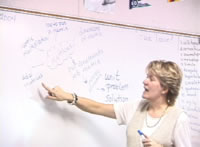 Learning Mathematics
Learning Mathematics 